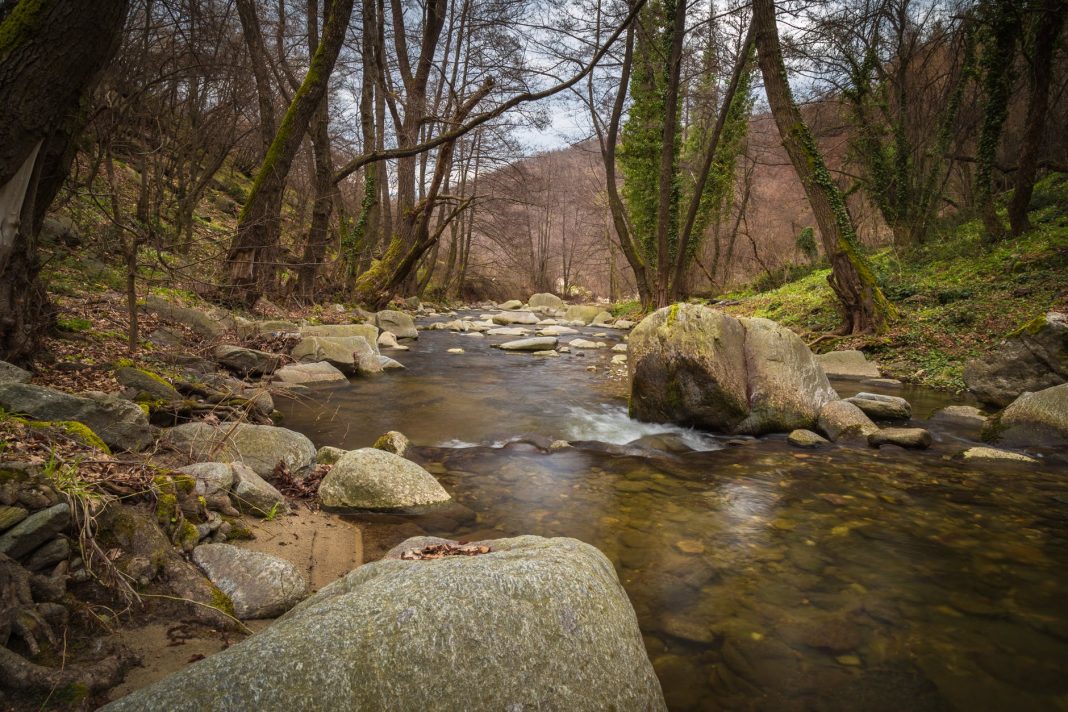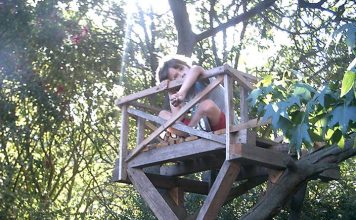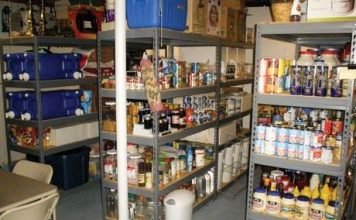| Website Exclusive • November, 2007 |
For eight years, Tracey and I lived in a solar powered home and for eight cloudy winters, we ran a small Honda generator every week to recharge our batteries. We understood that the original owner of our home had operated a small hydro system from the property’s year round creek but we never investigated this option because the creek ran through dense forest. Besides, we could just tell there wasn’t sufficient drop over its course.
|
We finally decided to use Backwoods Solar’s Site Level just to confirm hydro didn’t make sense. Much to our surprise, our traverse through the woods from a potential turbine site to a convenient intake location revealed about 80′ of drop. Not possible, we declared, assuming our technique must have failed. To double-check our method, we used the same Site Level to measure the drop from our water cistern to kitchen sink. We knew this drop equaled 56 feet because we had used a transit to measure it when this gravity fed system was installed. The review with the Site Level gave us about 60 feet and confirmed we knew how to use the level.
Voila, hydro potential. At the driest time of year, our creek measures about 3 feet wide by 3-4 inches deep and a five-gallon bucket and stopwatch suggested we had over 300 gpm flowing past our intake site. Wow, lots of potential. With 80 feet of drop, a nozzle flow chart indicated we could theoretically pass 134 gpm through a Harris 4-nozzle turbine equipped with 7/16″ nozzles. Next, we turned to Don Harris’ Motorcraft alternator watts output chart. With 134 gpm and 80 feet of drop, we extrapolated that we could generate 725+/- watts. However we would have an 1100 foot penstock to install. More charts. To reduce friction loss and maintain close to maximum output potential, we determined 4″ pipe would only sacrifice about 9 feet of gross head if all four nozzles were in use.
|
A quick assessment of the benefits of this quantity of energy convinced us to proceed with an installation. However, the year was 1999 and Backwoods Solar was incredibly busy catering to allot of Y2K hype leaving Tracey and I with little time for an install. And at that time, my hydro expertise wasn’t exactly expertise. So we called on Lee Tavenner of Solar Plexus of Missoula, MT to develop a turnkey system which would include his installation labor. Lee graciously pieced the components list together even though he understood we would provide the majority of the components; we agreed on a price; and he found time in his busy schedule for an install over one weekend in September.
Prior to that weekend, Tracey and I had to develop the route for the penstock through the woods through which the creek meandered. The path of least resistance followed old and overgrown logging skid roads as well as dense forest. We used survey ribbon to mark a path and hired a neighbor with a bulldozer to cut and clear the path. Another neighbor with a backhoe was hired to dig the intake pond, 4′ deep trench, turbine site, and discharge channel to the creek.
Lee recommended we use high-density polyethylene pipe given its resistance to crushing and the fact that it doesn’t crack when frozen. His Missoula distributor delivered thirty 40 foot pieces of the 4″ pipe to our remote homesite but could only get to within 1000 feet of our trench line. A Honda three wheeler could drag three pieces at a time to within 300 feet and Tracey and I carried each piece the balance of the distance. Not unbearable labor but a 40′ pipe can develop some great bouncing waves in it if your mutual pace isn’t synchronized properly!
|
These lengths of pipe must be fused together rather than glued as with PVC. Lee would rent the small machinery for this procedure and bring it with him when the installation weekend arrived. Our Honda 3500 watt generator would power the fusion machine.
Next, we gathered and installed the various power system components. Given the distance from the turbine to our battery bank measured 350 feet, we chose to install a 24 volt system. (Even though the PV system powering our home was 12 volts and many of our loads were 12 volt DC, we knew an EQ12/24-20 would enable us to maintain our 12v DC circuits and insure our 24v battery bank remained balanced.) The 350 foot distance from turbine to batteries and our 700 watt generating potential led us to select 1/0 direct burial copper cable in order to minimize transmission losses.
Other items ordered included: a 4 nozzle Motorcraft turbine from Don Harris sized for our site’s parameters; a Trace SW4024 inverter; a Backwoods Solar Powercenter kit built around the Trace DC250 disconnect box and Bogart Engineering’s Trimetric battery meter; a Trace C40 with digital display; two Enermax 900 watt airloads designed for 24 volt systems; an inline analog amp meter for measuring hydro current at the powershed; four Trojan L-16HC batteries; and miscellaneous cabling, fuses, etc.
|
Conveniently, we decided that our new system would be located in a workshop 100 feet from our home. The 12 volt PV system was confined to our home with solar modules on the kitchen roof, and inverter, batteries, etc in our living room. By relocating, we would remove the ever-present hum of that SW2512 inverter from our living space and significantly increase the distance between our wood stove and the batteries’ hydrogen gas. By installing our 24v system in the workshop, the only interruption in electrical service to our home occurred when we disconnected the SW2512 from our AC service center and reconnected the SW4024 to it; and when we disconnected our 12v fused power distribution box from our home’s Lineage batteries and reconnected it to the 12v half of our 24v Trojan battery bank in the workshop.
Lee arrived on a Friday night and stayed with us. First thing Saturday morning, we began the process of fusing the 1200 feet of 4″ HDPE pipe. Fusing is mostly a one-person chore, which Lee undertook. It consists of pulling together two ends of pipe and fitting them into the generator-powered fusing contraption’s housing. Once inserted, the pipe ends get locked in place and a lever controls their movement. A rotating cutting device with blades facing each pipe end is inserted between the pipe ends and the lever is moved, pulling the pieces into the blades which squares them to each other. Once squared, a heating element is placed between the ends; the generator brings the heating element up to proper temperature; and then the pipe ends are simultaneously pulled against it with the lever. The hot element is allowed to soften about ¼” of each pipe end; the element is removed; and the lever pulls the pieces together where they fuse to one another. The seam cools for a few minutes and onto the next junction Lee would go. Initially, I doubted the strength of this joint but repeated attempts to break the freshly fused seam failed.
While Lee fused, Tracey and I moved individual pieces of pipe to appropriately spaced fusing areas. As Lee finished a seam, Tracey and I would drag the ever-lengthening section of pipe away from Lee so he could fuse the next piece to it. Initially, Tracey and I could drag 200 feet of fused pipe towards the next staging area, but by mid-afternoon we groaned for Lee’s assistance after the fifth piece of pipe was attached. This process was exacerbated by the fact that the trench wandered from side to side of the cleared path as it achieved the straightest line from intake pond to turbine site. We repeatedly had to cross the trench and it’s mound of excavated earth as we moved pipe and the generator, as required. By nightfall, we were exhausted and still had 200′ of pipe to finish fusing. Had we known better and had Lee’s schedule permitted, I would have chosen to fuse the entire penstock prior to the trench being dug and utilize the three wheeler’s horsepower to pull pipe without the obstacle of the four foot deep trench and its entrails.
|
Back to the trenches Sunday AM. We finished fusing; threw the completed pipeline into the trench; and then attempted to insure that the pipe continually descended over its length. Of course, a four foot deep trench in often soft, moist soil sluffs, causing innumerable high spots which we painstakingly lowered by hand shovel. And then we buffered the pipe by hand with about 6″ of soil prior to the dozer pushing in the majority of fill over it, and threatening to cover us as well if we didn’t buffer quick enough.
At last, we could connect the turbine to the pipe. At the turbine housing (i.e.-a hole in the ground), we installed a pressure gauge, 2″ clean out, gate valve, and universal joint, in line before the turbine. Lee provided a custom-built plexi-glass catch basin with 6″ discharge coupling on which the turbine mounted. We fitted the turbine to the plumbing; attached a 6″ discharge pipe to the basin; connected the alternator to Battery (+) and (-); and opened the gate valve just after our beer. The pelton wheel buzzed; a quick push of the start button on the turbine’s control panel energized the alternator’s field; and its ammeter jumped into action.
However, our happy hour rapidly deteriorated. As we picked up, the almost fully charged Trojan L-16HC batteries quickly reached the bulk voltage setpoint, which we had programmed into the C40. As it should, the C40 would have begun to divert power but unknown to us, it immediately went into over-current shutdown. Unregulated, the battery voltage continued to climb. Eventually, we wandered into the powershed; detected an incredible smell of hydrogen; heard tremendous bubbling from the batteries; noted the C40’s orange LED yelling overcurrent; and raced to shut down the flow of water to the turbine.
Mystified, we double-checked all connections; confirmed polarities and voltages; and decided to start it up again just as the neighborhood began to wander in for a demonstration. Gate valve opened; current developed; voltage rising; C40 observed; and as the C40 began to divert, boom, overcurrent shutdown. More hydrogen; more bubbling; another race to the turbine; no power; and confused owners, installer, and neighbors. Even worse, we knew Lee had to leave for Missoula. He had already delayed his departure by a couple hours to get us to this point. Fortunately our batteries were full; we had the Honda generator if needed; and we could troubleshoot by phone.
|
Eventually Lee solved the problem. We had ordered a one ohm 900 watt Enermax airload. At 30 volts, this load would divert roughly 30 amps. However, when we measured the ohms of the installed Enermax, it registered only 0.5 ohms. Half an ohm and 30 volts resulted in an instantaneous 60+ amp diversion, hence the C40s overcurrent shutdown (our early model C40 was designed to shutdown above 62+/- amps). We exchanged the culprit for a one ohm version and the system immediately worked as advertised.
After a couple weeks of running two nozzles, we realized we had an abundance of energy. Our turbine had four nozzles and our creek could support all four if required but on a daily basis, we couldn’t use the energy two nozzles created. So we sold our solar panels; sold our 8 cuft propane refrigerator; replaced it with a 14 cuft Kenmore electric unit; brought home our 23 cuft chest freezer which had always lived at a neighbor’s with grid power; disconnected our 120v AC well pump from the generator circuit and reconnected it to our inverter’s AC load center; and we installed a 120v AC water heating element in our hot water tank. When it’s too warm for wood heated hot water, we open a third nozzle and switch on the AC water-heating element. Not unlimited hot water but enough for showers, dishes, and laundry for the two of us on a daily basis, if needed.
To date, we haven’t had to run four nozzles. Hard to believe that our creek with “so little potential” enables such a luxuriously powered alternative homestead and lifestyle. We’re delighted and reminded on a daily basis how fortunate we are when we speak with folks who struggle to make electrical ends meet on an off-grid budget.
Scott and Tracey are co-owners of Backwoods Solar, a catalog based business that specializes in alternatively generated electricity for remote homes where utility lines are not available or practical. The business is operated by employees who power their off-grid homes entirely by the products they sell. Click on the link above to visit their website.





















I like the idea of the elevated water tank system with return pump. I may consult an electrical engineer
We have a waterfall and a fast moving creek/stream that runs by our house on our property. We would like to build a hydro system. Not sure where to start.
A creek/river runs directly in front of our home. I don’t know where to begin on how to harness this as a power source. We are currently on-grid.
Very much interested in building a small hydro at a nearby creek to power my home.But need technical advice plus finance.Any tips?
We are looking for a system that we can run a home we plan to build. We have about a 1/4 acre pond that has a small creek flowing into and out of the pond. There is about a three or four foot drop out of the pond. Anyway hoping to find a better solution then solar. Hoping water can give us the power we need
How about using an elevated water tank to power hydro electric turbine ? Will that work.. Using a small pump for a return to tank .. I want to build it .. ELP !
looking for some guidance on building or installing a hydro system at my property on a small creek which is behind my home. Do you have plans that are available for purchase.